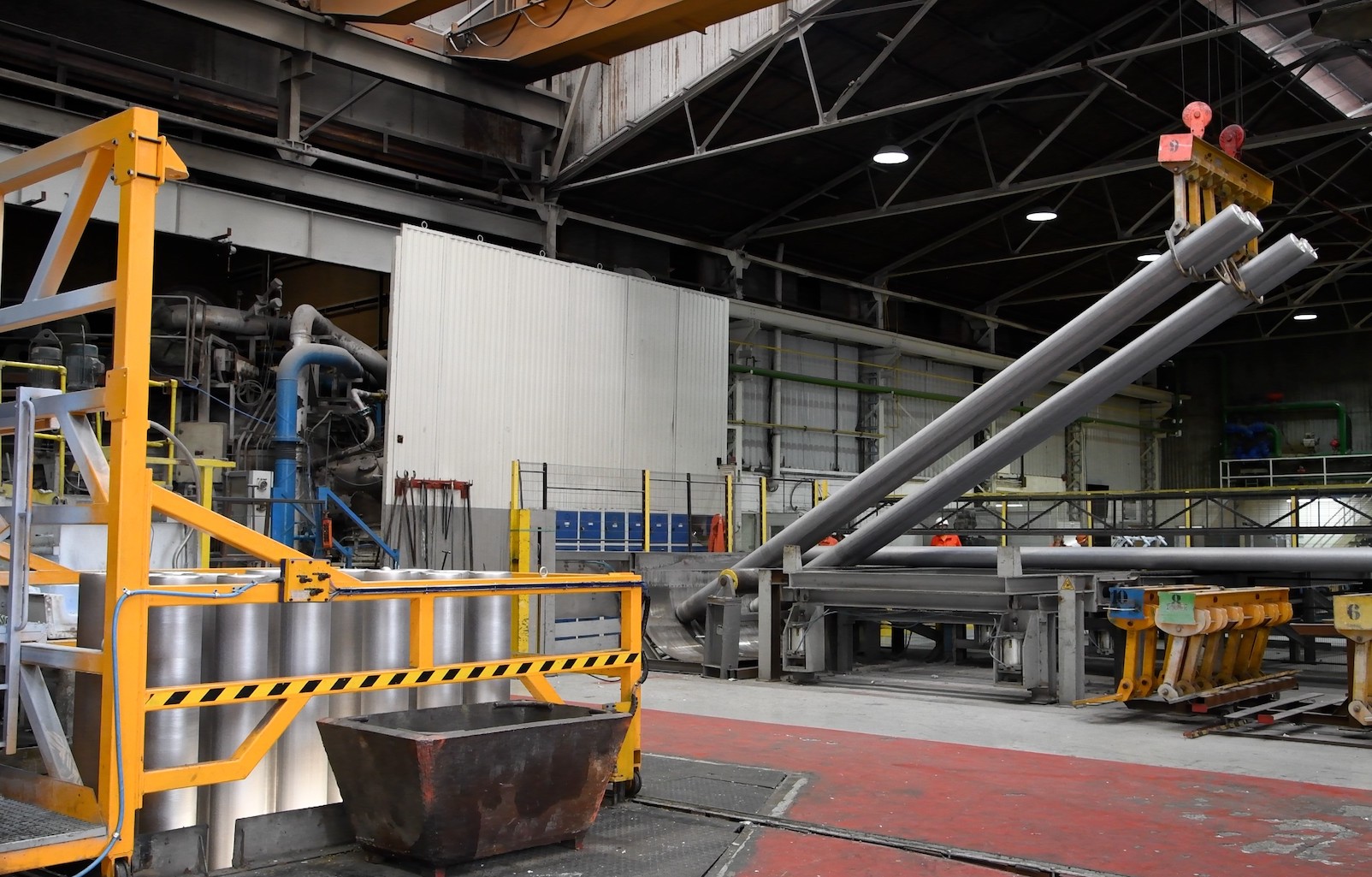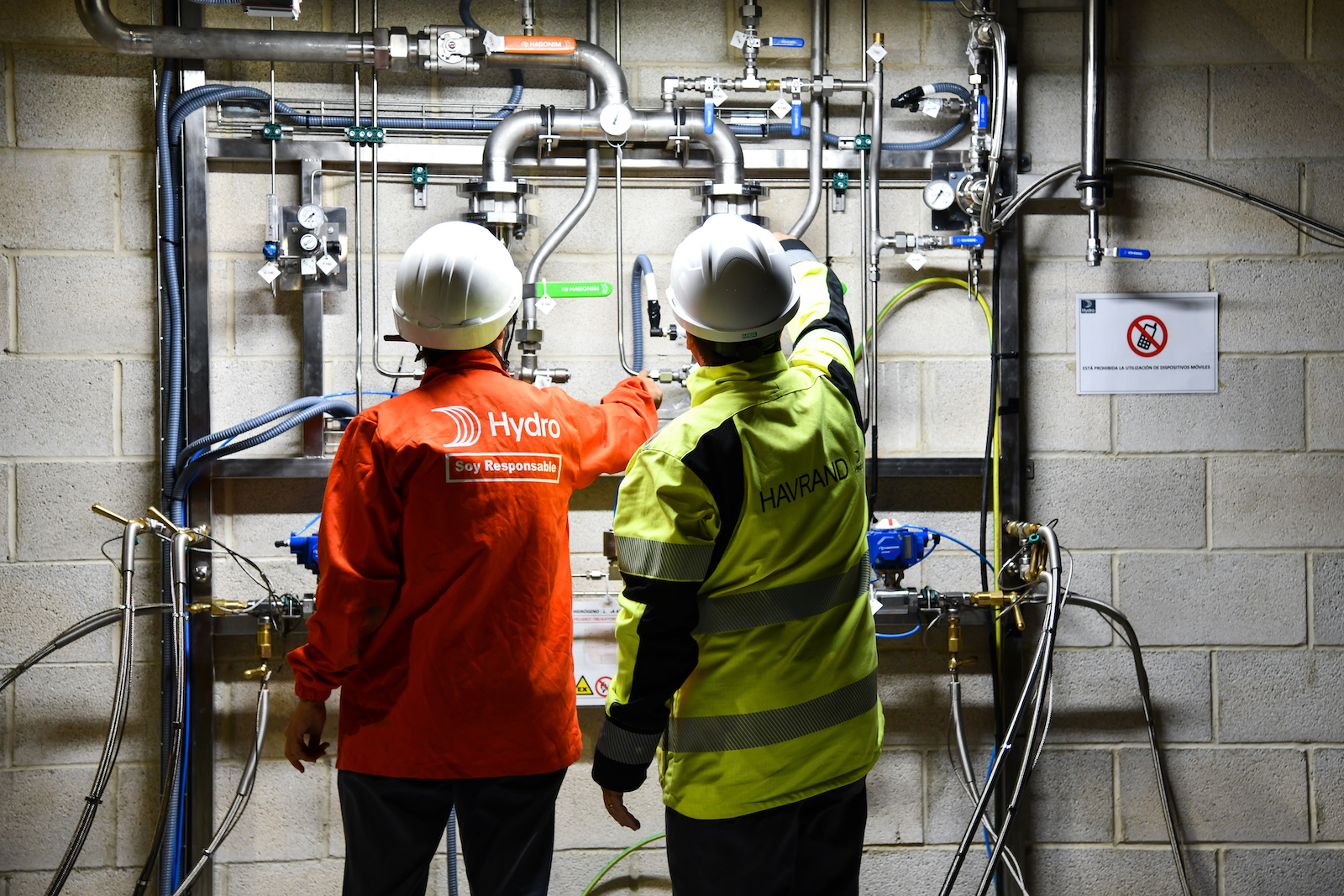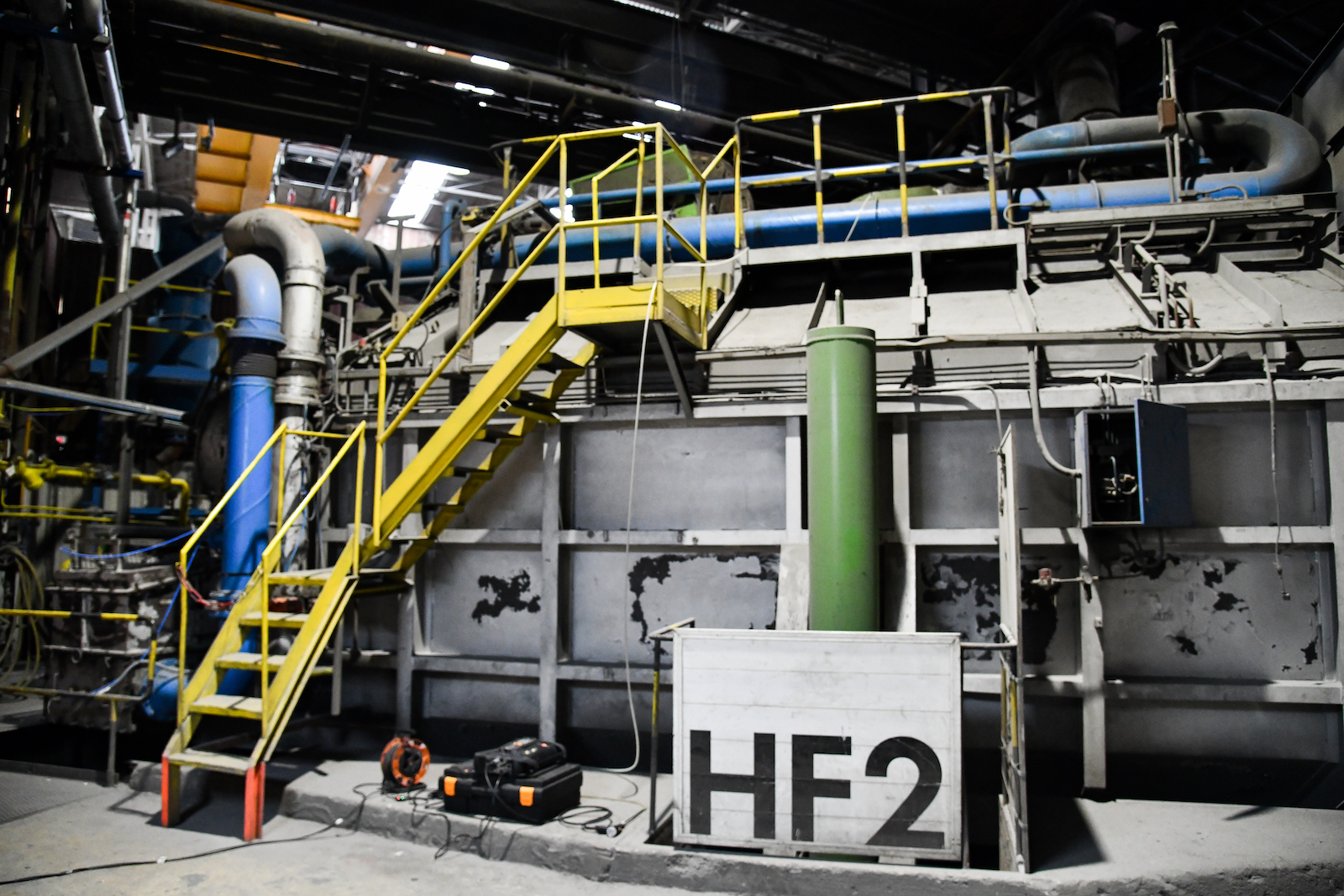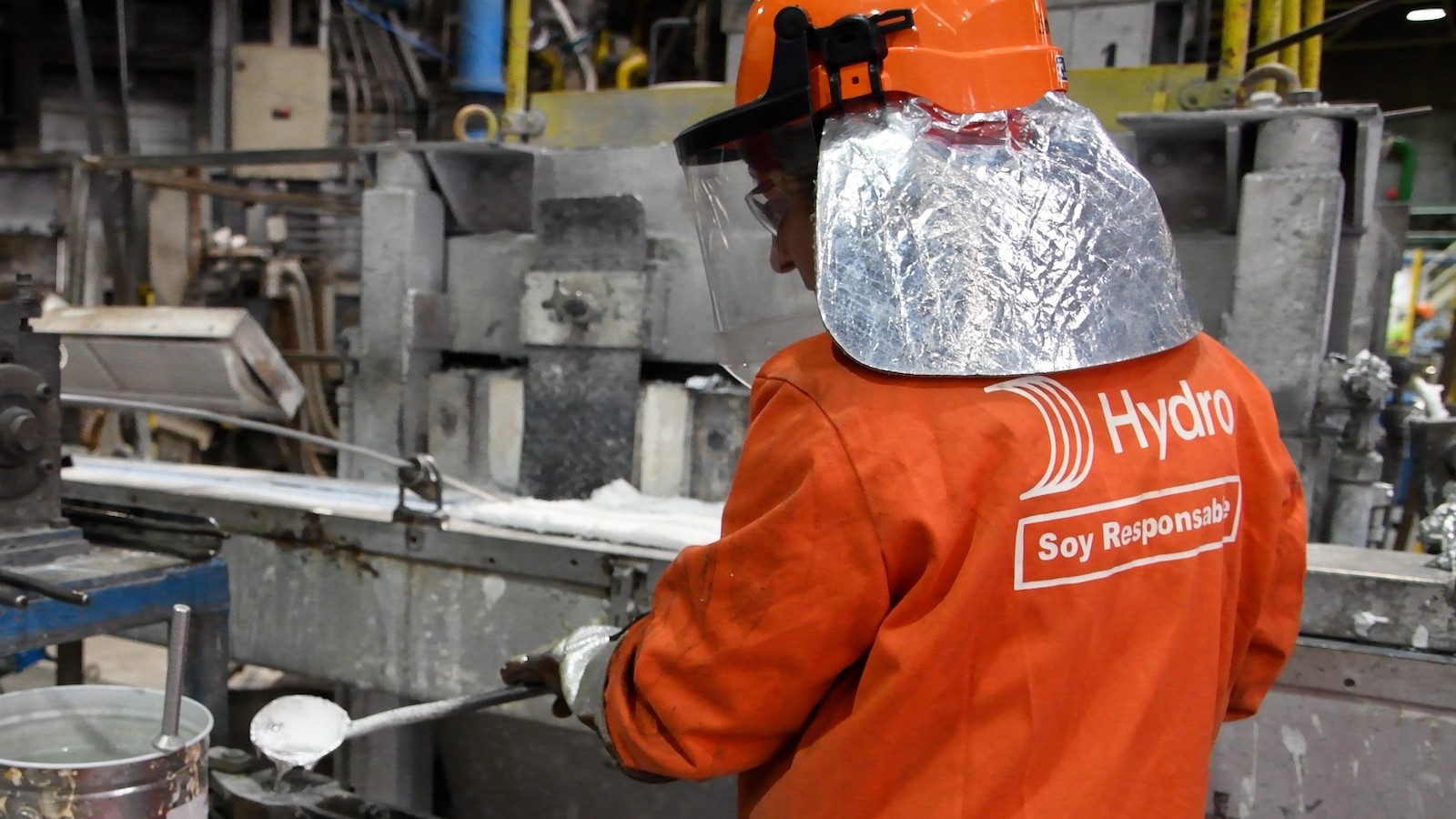
By Andrea Svendsen, Managing Editor.
Hydro successfully produced a batch of aluminum billet using green hydrogen as an energy source. Performed at the company’s extrusion plant in Navarra, Spain, the trial was conducted in collaboration with Hydro Havrand, Hydro’s green hydrogen company, and Fives, an industrial engineering group with expertise in hydrogen burner technology. According to Hydro, this was the world’s first known successful industrial-scale trial with hydrogen in aluminum production.
“We are excited to be conducting this test and it demonstrates Hydro’s commitment to decarbonization,” said Paul Warton, executive vice president for Hydro Extrusions. “By removing the carbon emissions from the energy source, we will be able to produce carbon-free aluminum from recycling post-consumer scrap.”
Meeting Sustainability Goals
Across a multitude of industries, there is a rush to decarbonize their processes down to zero emissions (or as close as possible). For example, a number of automotive OEMs have announced carbon neutrality goals. Porsche is aiming to be neutral by 2030, while Mercedes-Benz is targeting 2039 and other companies have listed targets for 2040–2050. In order to meet their net-zero targets, companies are working to eliminate their Scope 1 direct emissions from the manufacturing process, Scope 2 emissions from electricity generation, and Scope 3 emissions generated externally, such as raw material supply, according to the GHG Protocol standards.
According to Warton, aluminum products from Hydro represent Scope 3 emissions for its customers in the automotive, architectural, transportation, and other industries. As such, there is a need for Hydro to reduce its own emissions in order to best meet customer requirements. The company has enacted a number of initiatives in this regard—one of the most apparent being its ongoing investments in post-consumer scrap recycling. As just a few examples from the last year, Hydro announced plans to build a recycling plant in Torija, Spain, expand recycling capacity in Wrexham, U.K., and completed the purchase of the Alumetal recycling operation in Poland.
“We have a growing internal supply of recycled content,” said Warton. “Last year, Hydro Extruded Solutions produced about 1.3 million tons of aluminum profiles, and our internal recycling capacity across the globe is 1.2 million tons. Even though we still buy some primary material, we are almost self-sufficient with our own internal recycled material.”
Warton explained that recycling is only one part of the decarbonization process. Another element is the company’s work to lower its direct emissions from the recycling and extrusion processes (representing the company’s Scope 1 and 2 emissions). Therefore, the company is looking into alternative fuels for firing up its melting furnaces. “At the moment, all of our furnaces for melting scrap aluminum use natural gas, which has been an efficient burner solution over the decades,” said Warton. “But there are some alternatives that we are looking at, which could potentially lower emissions even further. Hydrogen is one of them, along with plasma and biomass.”
Hydrogen as a Potential Fuel Source
Hydrogen has been widely considered as an alternative to fossil fuels, because it is a non-toxic, highly combustible element that can be burned to produce heat with the only emissions produced being water. This makes it very interesting for a number of sectors—such as aluminum, steel, glass, and cement—as it could support decarbonization efforts.
However, the use of hydrogen has its challenges, as it does not naturally occur in large enough quantities to be widely used as a fuel source—which means that it needs to be manufactured. Currently, almost 100 million tonnes of hydrogen are consumed around the world each year (mainly used in oil refineries and ammonia production). Most of this hydrogen (around 99%) is produced using fossil fuels (natural gas or coal) in the steam methane reforming process, which involves a chemical reaction between steam and methane. This method of production has a high carbon content of around 6.6–9.3 t CO2/t H, resulting in 900 million tonnes of CO2 being emitted annually—essentially mitigating the potential benefits using hydrogen as a fuel.
An alternative is to produce hydrogen by using renewable energy to split water molecules into hydrogen and oxygen. Known as green hydrogen, this method of production does not emit any greenhouse gases. Hydro is very interested in green hydrogen and its potential role in supporting a global transition to a sustainable and circular economy, particularly in regards to aluminum. As a result, the company set up a new business unit, Hydro Havrand, which will specifically focus on the development of green hydrogen, with the aim of replacing fossil fuels across a range of sectors.
“The path to hydrogen started with the decarbonization strategy for Hydro’s aluminum processes,” said Per Christian Eriksen, head of Hydro Havrand. “Hydro is already a leader in low carbon aluminum through large shares of energy from renewable sources and electrification, but the next steps in decarbonization are harder. To tackle the hard to abate emissions from high heat processes, green hydrogen is seen as a very relevant pathway—especially in casthouses at remelters and recyclers.”
As a business unit, Havrand plans to develop and operate green hydrogen facilities, as well as provide guidance and expertise to enable industry to make the transition to renewable energy. For aluminum, this includes supporting the testing and trialing of hydrogen as a combustion fuel in melting furnaces. In addition, the business unit will be able to set up hydrogen production plants near aluminum facilities in order to generate enough hydrogen for the plant, as well as other industrial or consumer sectors in the local area.
Industrial Trial at Navarra
Despite the significant interest in hydrogen, no one in the aluminum industry had actually tested it as a fuel source on an industrial scale—until Hydro. Ensuring that hydrogen could be safely and viably used in aluminum melting requires a series of tests and trials at various stages. To carry this out, a team of researchers was pulled together. Hydro provided access to a casthouse and its casting expertise, while Havrand supplied its knowledge on hydrogen and integrating it in industrial operations. Fives drew on its previous work testing hydrogen and provided furnace and combustion engineering and expertise, and Nippon supplied the hydrogen for the trials.
The project involved two years of research and testing before finally conducting the industrial-scale trials over the course of three weeks in Navarra. There were two major concerns that the companies were focused on. First, the team had to ensure the safety of the people and assets involved in the trials. Second, they wanted to test the potential effects of the hydrogen on metal quality, since it needed to meet customer specifications and requirements.
During the first two years of research and development, the companies separately invested time, money and expertise in the technology qualification of hydrogen for aluminum. Hydro conducted a number of tests at its own operations, including theoretical calculations, computational fluid dynamics (CFD) models for various furnaces, engineering, and four lab-scale tests in Norway and Sweden.
At the same time, Fives conducted research in cooperation with Hydro and Havrand on hydrogen compliant burner and combustion controls design, which also included CFD analysis and lab-scale tests at their facilities in the U.S. “Fives investigated the new flow patterns and specific concentrations inside the melter with hydrogen as a fuel,” explained Alexis Omilion, senior business development manager for Aluminum Energy and Combustion at Fives North American Combustion Inc. “The CFD analysis coupled with hydrogen testing of North American TwinBed burners in our industrial laboratory offered insight into the burner and combustion system performance with hydrogen fuel.”
For the industrial-scale trials, Hydro decided to utlize its Navarra extrusion plant, which has a casthouse, two extrusion presses (2,000 and 4,000 tonne), and fabrication capabilities for the production of 1000, 3000, and 6000 series alloys for the automotive, transportation, renewable energy, and other markets. The Navarra plant presented an excellent opportunity to conduct the trial, because Hydro was in the process of replacing an old furnace at the end of its life. Access to this older furnace enabled the research team to prepare the test and perform commissioning activities without affecting the daily operation of the casthouse.
One of the first considerations in setting up the trial were the implementation of safety procedures, due to hydrogen’s explosive properties. Eriksen noted, “Since no one has ever used hydrogen in casthouses and hydrogen behaves differently than natural gas, we had to modify safety and firefighting systems, operational procedures, hazardous area classification, and so on to mitigate the risk of accidents to acceptable and manageable levels.” Some of the steps taken included:
- Implementation of an operations procedure detailing step-by-step the activities for each day of tests.
- Placing the hydrogen storage in an open area to allow for natural dispersion of the gas.
- Complete isolation of the hydrogen storage area, allowing only operators and HSE personnel to enter.
- Installation of new thermal cameras and firefighting systems, as well as firewalls in specific parts to contain a potential fire.
- Daily inspections performed on a “double buddy” system in the morning and afternoon (Figure 1).
- Splitting the connection from the trucks to the skid into four separate hoses to reduce gas velocities and potential leakage size in case of hose rupture.

The 27 ton tilting melting furnace (Figure 2) was set up to use green hydrogen, as well as a blend of hydrogen and natural gas. No modifications were made in the furnace itself, and only minor modifications were required for the combustion system, since the TwinBed regenerative burners (3.8 MW) with low NOx injection technology (LNI) were already compatible with many different fuels, including hydrogen. In addition to the burners, Fives supplied a Siemens PLC for burner and process management and the data acquisition hardware and software needed to monitor the performance of the combustion system throughout the tests. Along with this, the company engineered and provided a medium/low pressure fuel skid and the hydrogen and natural gas mixing station.
“Fives developed a fuel train for hydrogen, together with gas mixer and new hoses with material specification for hydrogen. They also provided an additional add-on to the original combustion control system to handle the hydrogen and hydrogen blends being delivered to the furnace,” said Eriksen. “This system ensured that hydrogen was injected safely into the furnace when temperatures were correct, automatically controlled the hydrogen flows, verified the interlocks, managed the need for purging, etc.”

Fives also supplied new low NOx fuel injector nozzles, which were tested at the end of the three-week trial. “Typically, each burner is equipped with one fuel injector mounted outside of the burner body,” said Omilion. “During the last day of testing, we equipped each burner with two fuel injectors, each designed for half of the total fuel flow going to the burner. While the changes to the injectors are not required for hydrogen operation, we were interested in testing the effect of dual injectors on NOx emissions.”
Completed over a period of three weeks, the industrial-scale trial utilized hydrogen or a hydrogen-natural gas mix to produce several different aluminum alloys under various process conditions. “Since hydrogen behaves differently and burns hotter than natural gas, the trial also investigated how these differences affect the aluminum melting process and the aluminum quality,” said Warton. “This is a necessary step on the path to maturing fuel-switch solutions from natural gas to hydrogen for aluminum. The results from this trial will not only be relevant for secondary aluminum, but also for the use of hydrogen in primary aluminum casthouses and other high temperature industries, like glass or cement.”
More than 200 tons of aluminum was produced over nine batches, all of which was intended for production and delivery to end customers. Team members from Hydro, Havrand, and Fives were present during the trial, observing and analyzing the process, while also ensuring that the aluminum produced met Hydro’s quality standards and requirements (Figure 3).

The results from the trial were generally positive, with the use of hydrogen showing no significant productivity losses, no major impact on metal quality and no unsafe incidents. “First, we learned that by setting up the right precautions, preparations, and safety measures, hydrogen can safely be introduced into high heat processes in aluminum casthouses,” said Eriksen. “We also saw few, if any, negative effects from using hydrogen as a fuel—and operationally, using hydrogen versus natural gas does not change much in regards to the process or aluminum quality. All tests so far show that we have achieved good production quality in the metal, and there was not any observed additional hydrogen pickup or dross formation.”
Next Steps
Hydro, Havrand, and Fives are now analyzing the trial results, including testing of the metallurgical properties of the aluminum and investigating the emissions from the process. In addition, Hydro is in the process of conducting final testing on the extruded metal produced using hydrogen as an energy source to confirm that the company’s quality standards are maintained during the extrusion process. The team expects to have a final report of these results from the Navarra trial ready in the fall.
Hydro and Havrand are also currently working to set up additional trials at other Hydro facilities in Europe. “With this test we have proven that it is possible to use hydrogen, but now we need to prove that this can be done with different configurations,” said Eriksen. “The next step is to test with different alloys and different types of post-consumer scrap, to test on oxyfuel burners, and also to test on an industrial scale over time. We also believe there is room for even further process improvements through dedicated and fine-tuned burners designed and operated for hydrogen. Hydro is planning activities in all of these areas within the next two years.”
All of this work, both current and future, is aimed at industrializing the use of hydrogen for a more sustainable future. “We hope to have marketable hydrogen-produced aluminum extrusion solutions for our customers,” said Warton. “We believe this will demonstrate that we have a route to zero carbon regarding the emissions from our own processes. If these trials continue to be successful, then that’s a big step toward giving the aluminum industry plenty of sustainable options in the future. If we can do it in one old furnace, then there’s no reason why we couldn’t copy and paste that technology onto all of the furnaces in our industrial system across the globe.”
Editor’s Note: This article first appeared in the August 2023 issue of Light Metal Age. To receive the current issue, please subscribe.
